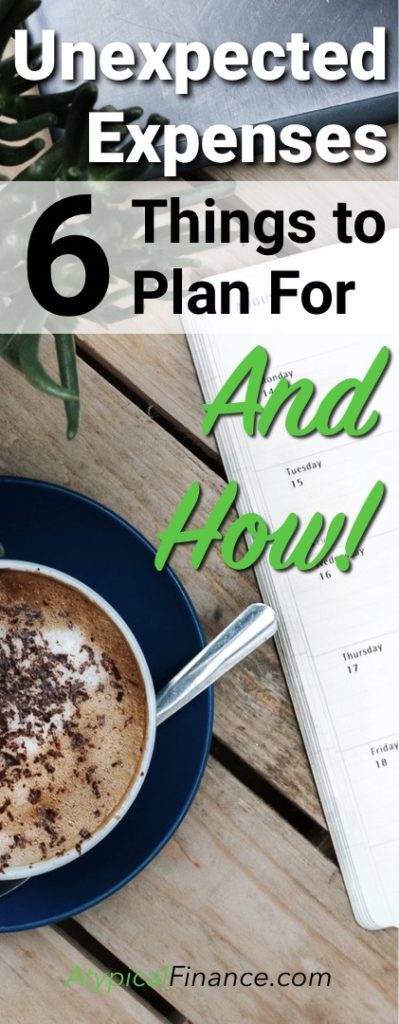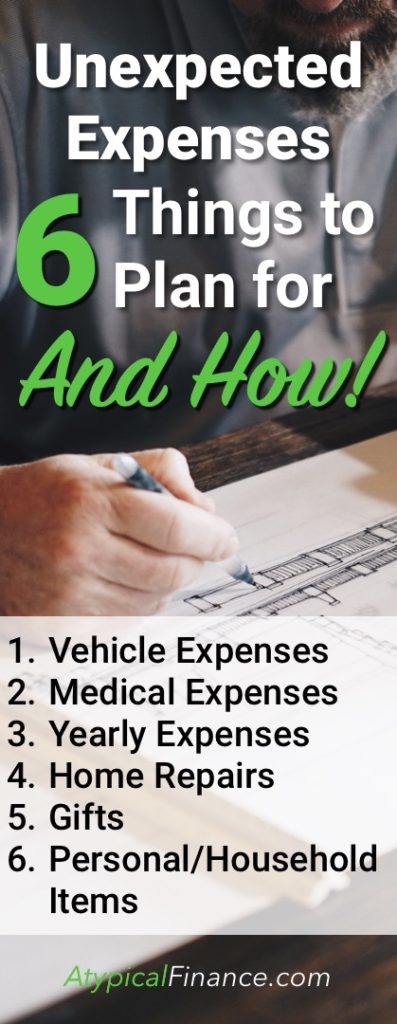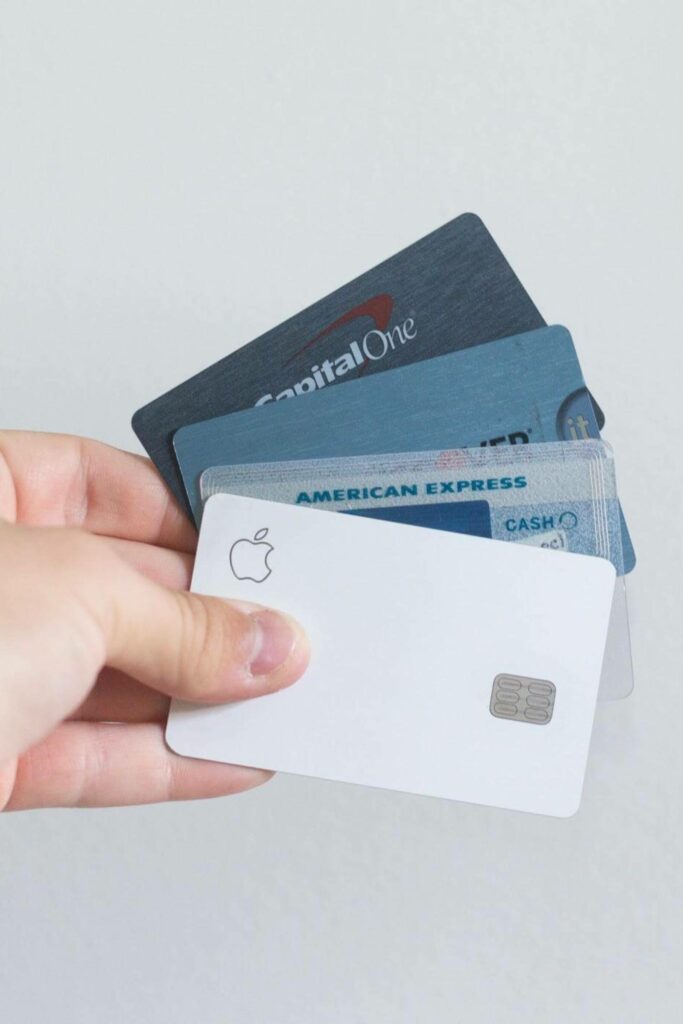Unexpected expenses—or what we think are unexpected expenses—come up all the time in our personal finances.
Have you ever been hit with an unexpected expense?
At one point I had to take my car in for some maintenance. I had what I thought were two leaky tires and an exhaust leak.
I was preparing for the cost of two plugs at $15 each and about $80 for the exhaust leak based on a quote from my wife’s car.
$110 isn’t bad for some vehicle maintenance.
They check out my car and delivered the news. Both tires needed to be replaced and I needed a new resonator for my exhaust.
The cost would be $486.10.
What I wasn’t expecting was that the alignment issue I thought I had a couple of months ago was a low or leaky tire. I had been driving on a low tire all that time and it destroyed the sidewall on both my front tires.
Great! (sarcasm)
The resonator is a small muffler underneath the center of your car further up the exhaust line. That was going to be $180 alone.
Expecting the Unexpected
Beware of little expenses. A small leak will sink a great ship.
– Benjamin Franklin
For me, that quote could also say “Beware of unexpected expenses.” There are some expenses that are truly unexpected.
Over the last 15 years or so, I’ve experimented and worked on budgeting—both my own and through helping others. It has taught me a lot about what isn’t an unexpected expense.
Essentially, there are very few truly unexpected expenses.
Having an emergency fund is essential and great, but there is a downside still.
When you have what we typically call an unexpected expense, you then need to rebuild your emergency fund after.
Money is still taken away from other goals like saving for a vacation or paying off debt. And that can lead to paying quite a bit more interest on your debt.
All that can be remedied by planning for these so-called unexpected expenses that will happen at some point.
Here are six expenses that should be expected.
 1. Vehicle Expenses
1. Vehicle Expenses
Does anyone in the virtual room have a new car?
Yeah, me either.
But if you do, you might think that your warranty will cover any unexpected expenses that might come your way. Unfortunately, that’s not the case.
Even on a new car, if you’re behind a truck that drops something off the trailer and destroys both of your tires, that’s your expense. The warranty won’t cover it.
Regular maintenance items such as oil changes, wiper blades, and engine maintenance should be expected expenses too.
Another thing that should be expected is vehicle registration. This only comes around once a year so it’s not top of mind for most people.
Some insurance companies have you pay every six months or yearly as well instead of monthly.
Let’s use an example of my fuel pump going out on my 2010 Chevy Malibu. According to the Cars.com RepairPal Price Estimator, it would cost between $612 – $877 to replace it.
If you’re paying off debt, you may only have a $1,000 emergency fund right now. This one fuel pump expense almost completely wipes that emergency fund out if you’re not planning for these expenses.
No matter how new your car is, something is going to go wrong eventually.
What to do Instead
For vehicle-related maintenance, start with a budget of $50 a month. Depending on how old your vehicle is—and if you have more than one—you may want to do more.
Both my car and my wife’s car are a little older so we budget $150 a month.
That recent car repair bill of $486.10 I spoke of? We already had $432.50 set aside for it.
It only felt like the repair bill was 53.60!
No stress. No worry. That’s why you want to save for these types of expenses.
Even for a new car, setting aside $50 a month from the month of purchase will be huge. That’ll give you up to $1,800 in the bank by the time a 3-year warranty on a new vehicle is up.
2. Medical Expenses
Medical expenses are often viewed as unexpected. The reality is that even if we are in great health, we are bound to get sick at some point.
A few winters ago, three of the four members of my family needed prescription medicine to get over being sick. Two of us had influenza B and the other had strep throat.
The prescription for strep wasn’t bad, but Tamiflu is frickin’ expensive!
The first time we had to buy Tamiflu they were out of the generic version. The total just for prescriptions for that winter since January was $543.81.
That is not including any payments for doctor visits.
That is more than the past three or four years combined!
Even with insurance, medical expenses can be fairly substantial, even for just routine viruses and bacterial infections.
What to do Instead
Well, that depends. Medical insurance plans can vary widely in cost and coverage.
A general rule of thumb is to set aside enough money each month to cover your yearly deductible. Divide your yearly deductible by 12 to get your number to shoot for.
For example, a deductible of $3,000 (divided by 12 months) will need $250 each month to cover it.
Variations in healthcare plan types and deductibles also affect how to handle medical expenses moving forward as well.
For instance, a PPO is a type of plan that generally has a higher premium but covers more money upfront. You may be set with just saving up one year’s worth of deductible instead of continually saving if you have a PPO. If you don’t use it for the year, you can just leave it for next year.
If you have an HSA (Health Savings Account) plan that has a lower premium but usually doesn’t cover anything (but wellness) until after you’ve completely paid your deductible, you may want to continue saving each month and each year whether you use it or not.
This is what my family does. We set aside pretax money each paycheck to go into our HSA account.
As long as the money is used for qualified medical expenses, you won’t have to pay income tax on it. At. All.
Vision and dental expenses would also fall into this category. It is recommended that you see an eye doctor once a year and the dentist every six months. These should not be considered unexpected expenses.
3. Yearly Expenses
Sometimes, expenses that we pay yearly seem to come around without us realizing it. We forget about them and then we’re surprised when it’s time to pay.
Here is a short list of some expenses that can be yearly rather than monthly.
- Vehicle registration
- Some insurance premiums (homeowners insurance especially)
- Data backup and storage
- Web hosting
- Seasonal supplies
- P.O. Box
- Amazon Prime membership
- Tax preparation
There are many things that you may sign up for as a yearly payment instead of monthly, so be on the lookout for these.
What to do Instead
Simply, anything that you pay for yearly should be divided up into twelve installments and planned for monthly.
I pay for two vehicle registrations each year. I set aside $20 a month to cover that expense.
The total expense is roughly $216 a year for both vehicles so this covers the expense and then some.
When you pay for a yearly subscription service upfront, divide it by twelve and put it in your budget.
Setting money aside every month as if you had a monthly bill also gives you the opportunity to examine if the yearly service you’re paying for is actually being used.
If it’s not worth it, then don’t hesitate to cancel it.
 4. Home Repairs
4. Home Repairs
Do you know what stinks about homeownership? Things break.
Do you know what really stinks about homeownership? Things that break are usually expensive!
Honestly, though, I don’t regret buying a home. But it is important to expect these traditionally unexpected expenses.
In our old house, we had to get a new water heater and water softener installed. We needed some extra work done for drainage in our crawlspace with that so that was about $1,600.
A few months later, we found out a tree was dying in our backyard after we had two large branches break and snap off. Removing that tree was another $1,300. Yeesh!
It was worth the cost when you consider the possibility of one of these heavy tree branches hitting and crushing one of my girls playing outside.
We didn’t expect those two events to happen specifically, but we did expect something to happen at some point.
What to do Instead
For homes, experts suggest setting aside 1% of your home’s cost on a yearly basis. So for a $200,000 home, you would be setting aside $2,000 a year, which translates to about $167 a month.
Just like with vehicles, if your home came with a Home Warranty for the first year, this is a great opportunity to save as you are pretty much guaranteed to only spend a couple of hundred dollars if something major goes wrong.
We personally set aside $250 a month for our home. Similar to your emergency fund, the amount you save each month is affected by your level of comfort and how much of a home repair you’ll be able to afford without dipping into your emergency fund.
You can also use an average of past home repair expenses to give you an idea of how much you should be setting aside.
Obviously, the more you budget each month, the bigger the expense you’ll be able to weather. However, putting aside too much money means that you’re missing out on your money working for you in investments.
5. Birthday and Christmas Gifts
I’m willing to place a bet that all of you reading this have a birthday every year. In fact, I bet your family and close friends have birthdays every year too!
In all seriousness, both birthday gifts and gifts around the holidays shouldn’t be considered unexpected. These things come around every year but there isn’t much of a plan for them.
This is one area I struggle with too. It always seems like a birthday for someone close comes out of nowhere.
Well, you know what both you and I should do?
What to do Instead
Put together a list of all of the birthdays you spend money on every year—Mom and dad, siblings, close friends, anyone who you regularly buy a gift for. Now set a limit for each person and then add all of it up.
Finally, divide all that by twelve and that will give you the amount you should be saving per month for gifts.
For Christmas and holiday gifts, again, write down every person that you buy for, set a limit, and then divide by twelve. Then, sock that money away monthly so there are no more “surprise” gifts.
This is also a great time to re-examine who you spend money on (and how much) and if there are some things you can do to cut back on gift buying.
6. Personal Care and Household Items
Have you ever run out of shampoo? Ugh! So annoying! Especially if you don’t notice it until you’re already in the shower.
I digress.
At some point, you’re going to run out of something that you use to either take care of yourself or your home. Things like:
- Garbage bags
- Toothpaste
- Shampoo and conditioner
- Laundry detergent
- Dish soap
- Makeup and makeup remover
- Vitamins
- Sandwich bags
- Toilet paper
- Paper towels
That list can vary and go on for miles. All of the things are items that we need on a consistent basis and that will run out.
What to do Instead
Set aside money each month to cover these. We have a separate budget for personal care—things we use on ourselves—and a separate budget for household items—things we use on our home.
We set aside $50 a month for personal care items and $100 a month for household items. Your mileage may vary.
Here is the Solution
I hope you’re noticing a trend here.
For all of these “unexpected” expenses, set money aside on a monthly basis to cover the cost when it comes up.
And it will come up.
You may need to experiment a little bit to figure out the amounts that will work best for you.
For a while, we tried to set aside $50 a month for household items. Some months it would be fine and others we’d go over. We increased it to $150 and that’s been the sweet spot so far.
The same thing has happened to us for other expenses as well.
Also, anytime a new expense comes up that you weren’t expecting, try to work that into your budget. It took us a little bit to figure out all of the unexpected expenses that we should be expecting.
After a few months of experimenting, you’ll be a pro at budgeting your newfound expected expenses.
So What’s a Real Unexpected Expense?
So what are some expenses that are truly unexpected?
To be honest with you, there isn’t a lot.
Real emergencies are things like a job loss or maxing out what your health insurance will pay due to some genuinely unexpected medical condition.
It should not be things like annual expenses, normal medical issues like flu or sinus infections, property tax, or home or car maintenance. These are all expenses that should be expected.
The last thing that I want is to have to use my emergency fund for what should be a totally expected expense only to lose an income the next month and not be able to make ends meet.
One Last Thing To Consider
Something to consider with this is that some may feel comfortable saving more and some may feel comfortable saving less. Based on your monthly income to expense ratio, you may be able to weather a larger expected expense than others.
If you feel comfortable only setting aside, say, $25 a month instead of $50 for car expenses because you have an extra $1,000 a month already, then by all means only set aside $25.
The only thing to consider with that is to make certain that your job (and your spouse’s job, if you’re a two-income family) is secure. You may not always have that $1,000 extra a month.
At some point, you may be relying more on your emergency or expected expense funds to help shore things up.
Either way, redefining what an unexpected expense actually means will help your financial situation tremendously. I want to do all I can to prepare for what may happen so I don’t lose traction if it actually happens.




















